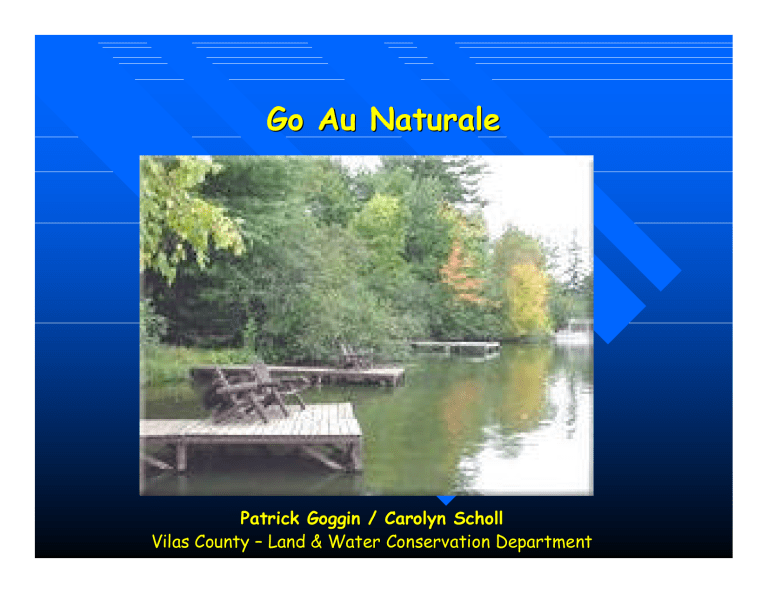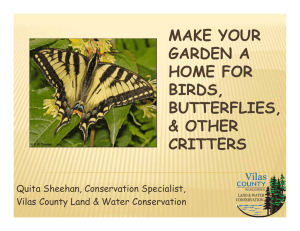Go Au Naturale Patrick Goggin / Carolyn Scholl Vilas County –
advertisement

Go Au Naturale Patrick Goggin / Carolyn Scholl Vilas County – Land & Water Conservation Department Talk Outline n n Shoreland buffer zone overview Structural & plant components of wildlife habitat n Checklist run through n Handouts overview n Q&A Structural and plant components of wildlife habitat Nest boxes n n Nest boxes & platforms are used by at least 46 species of northern wildlife Nest cavities can help supplement the availability of natural cavities Structural component n n n n n A ‘snag’ is a dead or dying tree To wildlife, a snag is a version of fast food 43 species of birds & at least 26 mammal species in the Midwest use snags as nesting sites, for perching sites, for territorial establishment, & as a food source A snag should be at least 6” in diameter X 15’ tall or larger Snags can be good locations to place suet feeders Dead trees (snags), fallen trees & perches Structural component Brush piles & rock piles n n n Provide escape cover, nesting sites & den sites for cottontail rabbits, weasels, woodchucks, skunk, fox, snakes, & other species Important to reptile & amphibian habitat if placed on the edge of a small pond with part of the pile submerged Rock piles can be excellent duck & turtle loafing sites if placed out in the water Structural component Cut banks, cliffs, & caves n n n n Unlikely you can create them, important features to maintain if you have them on your property Sites for kingfishers, bats, bank swallows, etc. Exposed cut banks in old gravel pits used by badgers, red foxes, coyotes & woodchucks Caves vital to bats & some invertebrates Structural component Salt n n n Salt & other trace elements are essential components of wildlife habitat Animals like deer, moose, pine grosbeaks, & crossbills will actively seek out salt Consult your local game warden or conservation officer before placing salt out Structural component Dust beds & grit n n n Both dust & grit are used by many wild birds to satisfy special needs Bobwhite quail, pheasants, turkey, & other birds control external parasites by dusting Mourning doves are an example of a bird that uses grit for digestion Structural component Water features n n n n Vital component in wildlife habitat, often overlooked on uplands near lakes Attracts songbirds, mammals, small reptiles, amphibians, & insects Can be provided in many forms from a dripping source to bird baths to backyard ponds, waterfalls, to natural springs, creeks, or ponds Dripping or flowing water is more attractive to wildlife than still water Structural component Feeders n n n n Providing supplemental foods already available For best results, provide feeding areas with ‘clusters’ of 4-5 different feeders that have different kinds of foods A protective shelter of poles, brush, & grass can be built up near the feeders to enhance a potential site Maintain feeders all winter as wildlife will become dependent on your hospitality in cold snaps especially Structural component Conifers n n n n Critically escape cover Winter shelter Summer nesting sites Sap, needles, twigs, buds, and seeds eaten by wildlife Plant component Grasses & legumes n n n n Ground nesting habitat Forage for plant-eating animals Cover for ground nesting birds’ young Hunting grounds for fox, raptors, owls, coyotes, weasels and skunks Plant component Butterfly, bee & moth plants n n n n Attract Midwest's 200 + species of butterflies, moths, & bees Supply butterfly caterpillars need for food & nectar sources for adults Herbs are great for bees, moths, & butterflies Bee plants include fruit trees & shrubs, berries, daffodils, lilacs, & pussy willows Plant component Hummingbird plants n n n n Ruby-throated hummingbirds common locally Flower nectar & tiny insects it’s preferred diet Tubular red flowers attractive to hummingbirds Spread plants in bloom over season like columbine, bergamont, lobelias, salvia, scarlet trumpet vine, etc. Plant component Summer fruit, berry, & cover plants n n n n Planting a landscape component comprised of trees, shrubs, aquatic plants, & wildflowers which provide food and nesting cover from June through August Fruit & berry plants vital Shrubs that form thickets Wildflowers & aquatic plants that provide food & cover Plant component Fall fruits, grains, & cover plants n Landscape includes shrubs, grasses/grains, & cover plants ripening in fall Plant component Winter fruits & cover plants n Best winter wildlife plants are characterized by two qualities: persistence & low appeal to wildlife when they first mature Plant component Nut & acorn plants n n n Hardwood trees good long term investment in wildlife production Significant food in fall & winter for whitetailed deer, turkey, ducks, squirrels, ruffed grouse, black bear, & other species Many of these species also contain natural cavities that are used by up to 96 species of wildlife Plant component Checklist overview Handouts n n n n n n n n “The Water’s edge” Native plant lists Web sites listing Fiber logs flyer ““What is a shoreland buffer?” “A fresh look at shoreland restoration” Program application Business cards “Water is the most critical resource issue of our lifetime and our children’s lifetime. The health of our waters is the principal measure of how we live on the land” - Luna Leopold Questions ?







